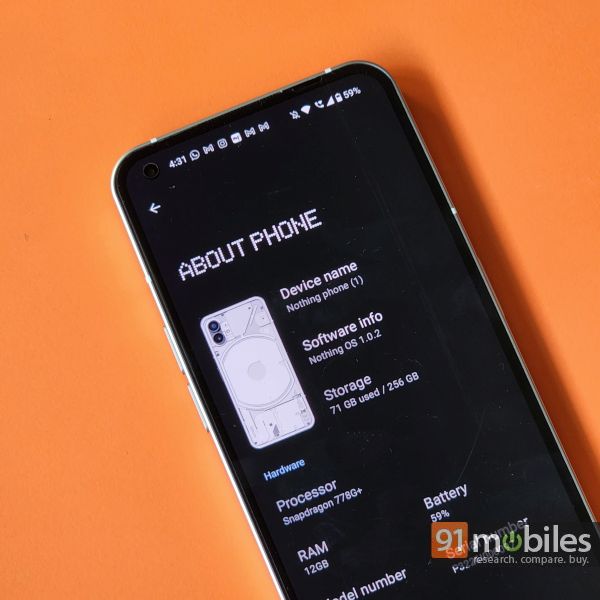
Nothing Phone (1) recently made its global debut, including in India. The phone has received a lot of attention lately, briefly outperforming iPhones. The company’s first smartphone was promoted using the same strategies as the OnePlus One’s launch campaign. A mid-range smartphone at its core, the Nothing Phone (1) veers away from OnePlus’ shadows and is being sold at a premium price with the promise of a seamless experience. The Qualcomm Snapdragon 778G+ SoC powers the phone, and one of its talking points is Glyph, a group of 900 LEDs that have been thoughtfully arranged in certain patterns on the rear of the device.
Other features of the phone include a 6.55-inch Full HD+ OLED panel with a 120Hz refresh rate and symmetrical bezels, Android 12 out of the box with Nothing OS on top, and a pair of 50MP cameras on the back. A respectable 4,500mAh battery powers all of this. In our review, Nothing Phone (1) performed admirably. We’ll go over four reasons to buy the Nothing Phone (1) in this article as well as four reasons not to.
Table of Contents
4 Reasons To Buy Nothing Phone (1)
Unique Design: The design aesthetic that is typically used on products across industries has never been a priority for Nothing. After presenting their version of the Nothing Ear (1), the company has now done the same for the Phone (1). You receive a phone constructed of plastic and aluminium. The phone’s body is similar to that of an iPhone, with flat sides and a vertically positioned dual camera arrangement on the back. Nothing invested a significant amount of time in the phone’s back, providing you with a clear phone and the Glyph user interface. A brilliant OLED panel with a punch hole on one side and symmetrical bezels throughout can be seen on the front. There are two colour options for the phone: Black and White, and neither is a bad choice.

Clean Software: The Phone (1) gets a near-stock interface with the company’s Nothing OS v1.0.2 on top of Android 12. The OS is a unique type of custom skin that ships free of bloatware. The company has introduced unique fonts, wallpapers, and a few unique apps in addition to very fine adjustments to the notification panel. The OS and the Chip both play a significant role in this scenario, and this nearly stock UI runs smoothly on a mid-range chip to provide you with a pleasant experience.
Decent Cameras: The Phone (1) uses a dual 50MP sensor on the rear with the main sensor being the Sony IMX766 which comes with support for both OIS & EIS. This sensor is a strong performer and is well-liked by OEMs for a budget to mid-range handsets. A 50MP Samsung JN1 sensor, which serves the dual functions of ultra-wide and macro in this situation, supports the primary sensor. When compared to the competition at this price, the phone’s camera performance is respectable.

Excellent Battery Life: The phone has a large 4,500mAh battery, which, although it may appear little on paper, works like magic. The phone routinely provided six or more hours of screen time throughout the short time we had it, which is excellent. In addition, the phone supports 33W wired fast charging and also offers features completely unheard of at this price point, like 15W wireless charging, and 5W reverse wireless charge. There will be questions regarding the charging brick not being included in the box, and we will address this in the latter part of this post.
4 Reasons Not To Buy Nothing Phone (1)
No in-box accessories: Nothing removed the in-box accessories in the same manner as tech titans Apple and Samsung. Applying this approach to an already premium mid-range phone doesn’t make sense, but it can be justified on a flagship or low-cost smartphone. When combined with the accessories, the phone joins a market dominated by budget flagship competitors including the iQOO 9 SE, realme GT 2, GT Neo 3, OnePlus 10R (review), and the Xiaomi 11T Pro, all of which are marginally more powerful than the Nothing Phone (1).
Low Display Brightness: Although the Nothing Phone (1) has a 10-bit 120Hz OLED panel, the panel quality is not that great. One area where the company appears to have scrimped is the max brightness, which is only 500 nits. Except for YouTube, no other app lets you play HDR video, despite the company’s promises that the HDR10+ certified display can reach 1200 nits while playing HDR content. Therefore, it appears that Nothing also scrimped on obtaining the certificates required by Prime Video and Netflix to enable HDR streaming functionality.

Overall Value: Despite all the fanfare and glamour surrounding the Phone (1), it is unquestionably not for the general public, or at least not for the general public in India. The phone is intended for the buyer who wants something unique yet is willing to spend more for a well-rounded experience. When compared to devices like the POCO F4 (review), iQOO Neo 6 (review), or even the IQOO 9 SE, the phone’s performance is lacking and it is easy to write it off, but it excels in other crucial areas. In conclusion, the Phone (1) is a compelling purchase for individuals who place the software and design of a phone above all else.

Quality Control Issues: This is something that has recently been observed online as soon as the first batches of retail devices began to reach their customers. Dead pixel occurrences, an uneven display with visible colour shift and black crush, and moisture seepage in spite of the phone’s IP53 protection are all signs that the company does not have adequate quality control procedures in place. The strategy of creating artificial scarcity to increase demand is not working in this case either.

















